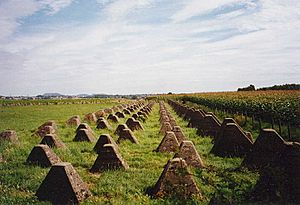Dragon's teeth (fortification) facts for kids

Dragon's teeth (also called Drachenzähne in German) are strong concrete blocks shaped like pyramids. They were first used during World War II to stop tanks and other military vehicles. The main idea was to slow down enemy tanks. This would force them into areas where they could be easily attacked by special anti-tank weapons. They were used a lot, especially along the Siegfried Line in Germany.
Dragon's Teeth in World War II
Many armies in Europe used dragon's teeth during World War II. The Germans built many of them. You can find them on the Siegfried Line and the Atlantic Wall. Each "tooth" was usually about 90 to 120 centimeters (3 to 4 feet) tall. The exact size depended on the specific design.
Soldiers often placed land mines between the individual teeth. They also added other obstacles. These included barbed wire to stop soldiers on foot. Sometimes, they used diagonally placed steel beams to make it even harder for tanks to pass.
In the United Kingdom, many dragon's teeth were built in 1940 and 1941. This was part of their plan to strengthen defenses. They wanted to be ready for a possible German invasion.
These defenses were very strong. The dragon's teeth were built on a concrete base. This base was often 10 to 30 meters wide. It was sunk deep into the ground. This stopped enemies from trying to dig tunnels under them. The teeth themselves were pyramid-shaped concrete blocks. They were about one meter tall in the front rows. Back rows could be up to two meters tall.
The teeth were placed in a special way. This made it impossible for a tank to drive straight through. Between the teeth, there were often minefields and barbed wire. There were also strong concrete bunkers called pillboxes. These pillboxes were very hard to damage with artillery. They were placed to allow German soldiers to fire across the whole area. The only way to capture these pillboxes was for soldiers to get behind them. But often, there were more rows of teeth and pillboxes behind the first line.
Because so many were built and they are very strong, thousands of dragon's teeth can still be seen today. Many are found in the remains of the Siegfried Line.
Dragon's Teeth After World War II
Some countries still use or maintain lines of dragon's teeth. Switzerland keeps them in certain important areas. In their military, these lines are sometimes called "Toblerone lines." This is because they look like the triangles of a Toblerone chocolate bar.
Dragon's teeth are also found along parts of the Korean Demilitarized Zone. They were also used on the East German side of the Berlin Wall.
The term "dragon's teeth" is still used today. It can describe any line of posts or pegs. These are set into the ground to stop vehicles. For example, you might see them in car parking areas or along roads. Another word for such a post is "Bollard".
Some countries, like those formed after Yugoslavia broke up, have movable teeth. These are placed at the sides of roads in important spots. They can be lifted and put onto the roads to block them if needed.
Some stages of the Rallye Deutschland race happen on military training grounds. These roads are lined with dragon's teeth, which are called "Hinkelsteine" there. They are usually there to stop tanks from leaving the roads. If a rally car goes off track, hitting these can cause a lot of damage.
Images for kids
-
World War II dragon's teeth at Fairbourne Beach, Wales, in 2009, designed to stop tanks landing
-
Dragon's teeth on GHQ Line near Waverley Abbey, Surrey in 2006
-
United States Army troops passing through dragon's teeth on the Siegfried Line in 1944.
See also
 In Spanish: Diente de dragón para niños
In Spanish: Diente de dragón para niños





